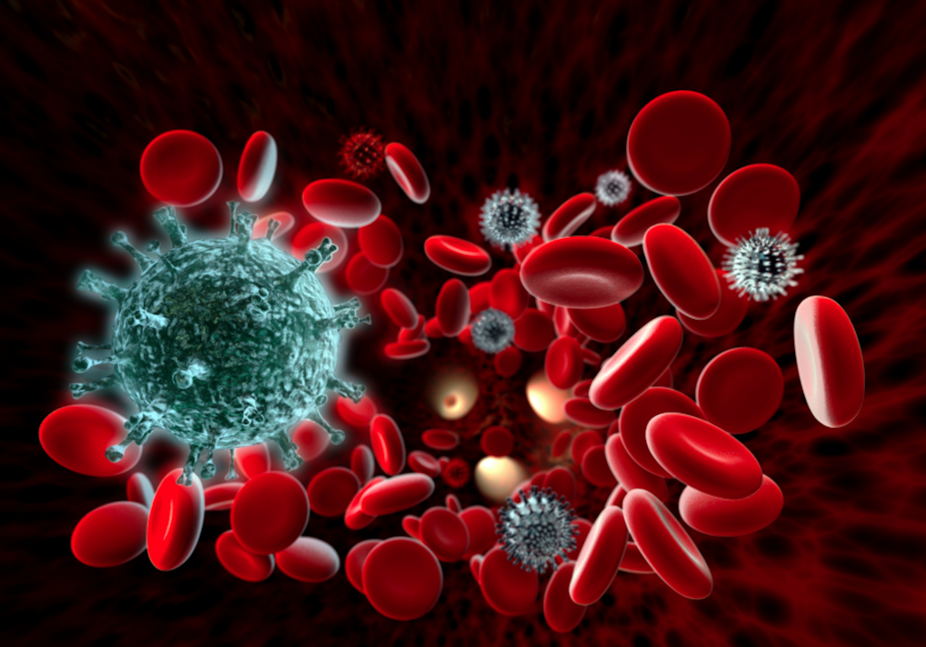The presence of foreign objects, like viruses, in our bloodstream is usually a bad thing. Evolution has created some extremely efficient immune cells that patrol the blood, seeking out material that should not be there, and shutting it down.
Sometimes, though, viruses circulate in the blood for beneficial purposes. Gene therapies often deliver viruses as couriers to deliver new DNA to repair faulty cells. Getting viruses into the bloodstream is simple, but keeping them “active” during their time inside the body is difficult. This is particularly true if the immune system has encountered them before. Even though therapeutic viruses are engineered to be beneficial, the immune system doesn’t recognise the difference, and starts a defensive response.
Now a team led by Federico Mingozzi at the Children’s Hospital of Philadelphia has come up with a way of preventing such therapeutic viruses from being decommissioned by the immune system, by hiding the virus particles inside a cloud of decoy empty virus particles.
As they report today in the journal Science Translational Medicine, the team developed an engineered version of adeno-associated virus (AAV) as a genetic courier for the treatment of haemophilia B. This disease stems from a mutation in the DNA of liver cells that prevents them from producing normal levels of an enzyme called coagulation factor IX. Such patients can bleed to death without proper treatment.
Mingozzi’s AAV was designed to deliver a DNA payload to the liver. This DNA contained instructions to produce the correct version of coagulation factor IX, a crucial protein involved in blood clotting, in the hope that it would cure this genetic disease.
Stealth tactics
Viruses consist of two parts: a genetic core (either DNA or RNA) and a protective protein shell. When a virus infects a human, the host immune system typically triggers a cascade of defensive reactions. One of the most effective responses is the production of neutralising antibodies that recognise and attach to the virus shell and squelch its activity.
Mingozzi’s choice of AAV as a genetic courier would seem counter-productive then, since between 30% to 60% of the human population has previously been exposed to AAV. Thus, their immune systems have learned to recognise AAV shells. In such immune individuals, even though the engineered version of AAV contains beneficial genetic information, it gets quickly tagged for destruction and obliterated long before it reaches its target destination (the liver).
Even when a large number of AAV particles are administered to improve the odds of some getting through, the immune system mops them up. The few particles that do survive the journey initiate the production of normal coagulation factor IX in liver cells, but only manage to reconstitute around 10% of the normal volume of the coagulation factor IX pool.
So Mingozzi came up with an idea to fool the immune system. He mixed therapeutic AAV particles containing the right genetic information with lots of empty AAV shells lacking a DNA core, and injected them into mice (used as a proxy for humans). This created a smokescreen, allowing the therapeutic AAV particles to dodge the immune system’s attack.
This new approach enhanced AAV survival in the bloodstream of mice. Depending on how immune each individual mouse was to AAV, a personalised ratio of empty AAV particles to real AAV particles was administered. Mice with higher levels of AAV antibodies received more empty decoy shells.
Circulating AAV antibodies, which exist in immune individuals, attacked both empty and active versions of AAV, but enough active virus got to the liver to boost coagulation levels beyond those seen in an average mouse. These beneficial effects lasted up to four weeks – an excellent timeframe given that a severely affected haemophilia B patient has to inject themselves every day.
They also tested out the same idea using animals more closely related to humans - rhesus macaques – where the presence of decoy virus gave real AAV particles the same survival extension, and boosted coagulation factor IX levels to a similar degree.
Importantly, when different monkey tissues were examined after administering empty and real AAV formulations, all the activity predominantly happened in the liver, with no unsafe, off-target effects in other organs.
Perfecting the decoy trap
The first generation of decoy viruses used in this study were designed to be exact replicas of AAV, but without the DNA payload. Unfortunately, these decoy viruses behaved too much like the real thing, attaching to target liver cells and by virtue of their overwhelming numbers, out-competing the binding of real, therapeutically-relevant virus. Once inside liver cells, bits of these empty viruses then presented enticing foreign targets to the immune system.
Tweaking the design of the empty virus shell in the second generation of decoy viruses prevented it from binding liver cells, boosted the binding of real virus and replicated the rise in coagulation factor IX levels. It also had the happy consequence of dampening certain sections of the immune response.
Using fake viruses as bodyguards is an ingenious way of protecting therapeutic viruses in the bloodstream. This approach could represent the start of a therapeutic revolution for haemophilia B patients, and others with genetic diseases.

